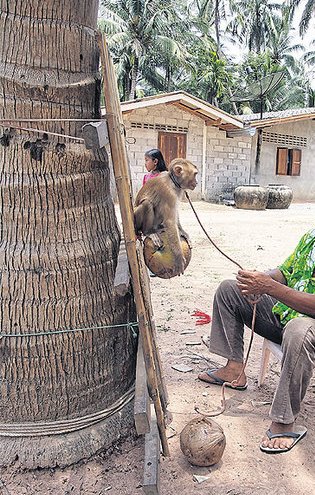
Read the article by Jennifer and I in the Huffington Post by clicking here.
Agile and adept climbers, such monkeys–native to coconut growing regions in Southeast Asia–are capable of harvesting several hundred more coconuts a day than a human can; reports vary widely as to how many coconuts a day one monkey can pick, ranging from 300 to 1,000. Monkeys are chained by the neck and trained to pick only ripe coconuts and are then forced to do so, day in, day out and all day long. They are trained at monkey training facilities one visitor described as follows: “The primitive, primate campus, a simple, open sided shed,” contains, “individual, meter high stakes, driven into the dirt floor… Onto each perch is tethered a solitary monkey by collar and chain. There are a dozen such perches, each one just out of reach of its neighbor.”
During training and beyond, the monkeys are tethered or caged 24/7, sometimes with little to no opportunity for socialization. Where do these monkeys come from? According to one monkey handler, “Sometimes the monkeys are offspring of berok (already trained monkeys); sometimes they are caught [by poachers] on the forest with nets or traps. Often though, nursing mothers are shot and their babies are taken.”
And though many articles about these monkeys contain quotes from handlers who state that they care about their animals, it is impossible to square such assurances with the long hours, hard labor, constant shackling and lack of autonomy these animals are forced to endure day in and day out for no personal benefit. Indeed, one handler admitted that sometimes “the monkeys are so tired from picking coconuts that they faint.”
It is, in a word, slavery. And as human nature and history demonstrate again and again–where there is a profit to be made on the backs of non-humans, those backs are strained and often broken.
Read the full article here.
Read the Washington Post article here.
Read the Bangkok Post article here.
————-
Have a comment? Join the discussion by clicking here.